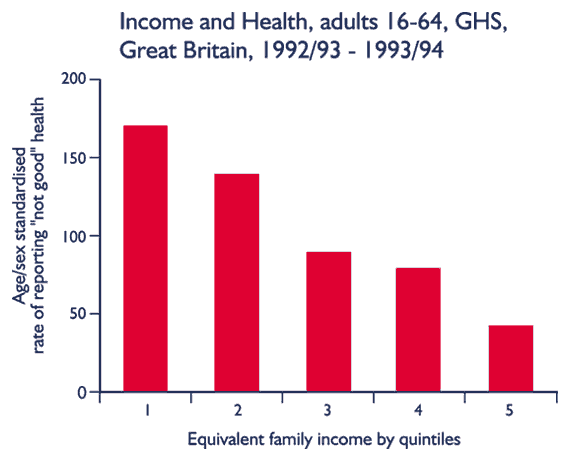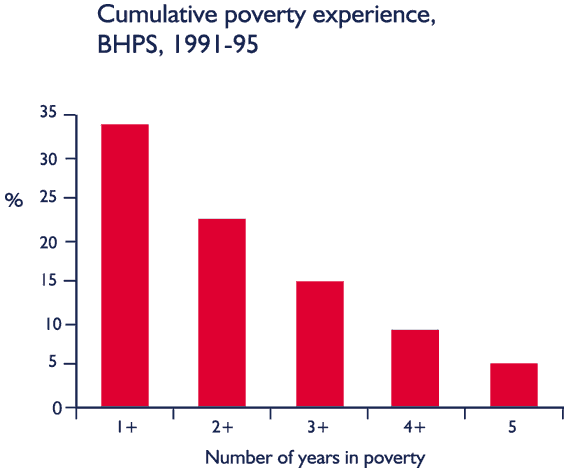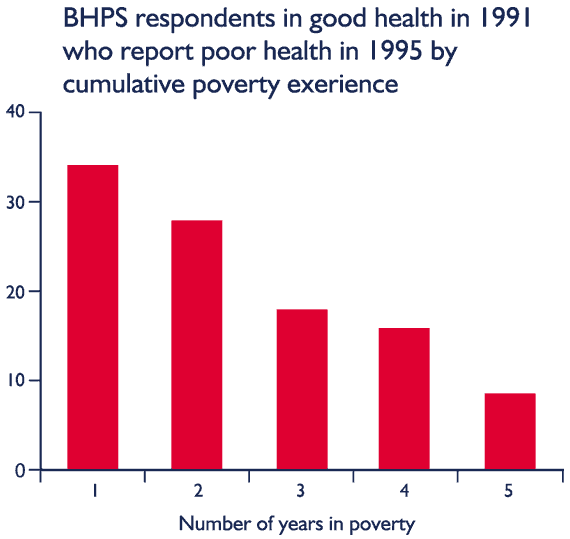 |
Close
window to return
|
Issue 1, January 1998, pp.12-13.
Poverty
and Health
Michaela Benzeval and Ken Judge
Poor and in poor health
It has long been recognised that poverty is associated with poor health
(see articles by Margaret Whitehead and Sally Macintyre, Health Variations
Programme Newsletter, Issue 1, pp. 4-7). This powerful and persistent
relationship is illustrated in Figure 1. After adjusting for differences
in age and sex, there is a very striking relationship between self-reported
health and level of income. Those respondents whose income is in the bottom
20 per cent of the distribution are over 3.5 times more likely to report
'not good' health as those in the top fifth.
Figure 1

(Authors' analysis of GHS)
Which is the cause
and which the effect?
While the association between poverty and poor health is well-established,
the direction of causation is not always clear, mainly because most existing
research is based on cross-sectional analyses. Such data can be quite
misleading. Some people may have poor health because of low incomes while
others have low incomes because of prior sickness. Without some knowledge
of the sequence and timing of events, it is almost impossible to establish
the nature of the causal relationship between poverty, low income and
health.
Moreover, recent research findings make it increasingly clear that poverty
is a dynamic not a static concept. Although some people face long periods
of sustained financial hardship, a large number of others move in and
out of poverty in various ways and for differing periods of time. Figure
2 employs data from the first five waves of the British Household Panel
Survey (BHPS) 1991-95 to illustrate what has been happening in Britain.
It shows the proportion of people who have experienced varying lengths
of time in poverty, defined as equivalised household income falling below
50 per cent of the mean household income. While one third of people had
experienced at least one year of poverty, only five per cent were in poverty
for the whole five year period.
Figure 2

(Authors' analysis of BHPS)
Such "poverty churning" may have very important implications for the relationship between income and health. As Walker and Ashworth (1994)(1) have explained:
. . . a brief spell of poverty is not the same as a lifetime spent with resources outstripped by need and . . . neither is [it] the same as repeated bouts of poverty separated by time that may allow for some financial and emotional repair. [For example,] . . . during spells of poverty, psychological well-being may well reflect a complex interplay between factors that change with time: frustrated expectations and stress caused by the need to budget on an exceptionally low income for long periods, contrasting with growing expertise in what may be relatively stable financial circumstances.
pp.139, 38-9
What we know from
previous research
It is important to consider the distinct effects that different dimensions
of income and/or poverty dynamics might be expected to have on health.
As yet there are only a relatively small number of studies - mostly from
Canada, Sweden and the USA - that have examined the impact of levels and
changes in income on health. These vary in quality and focus but they
do confirm that poverty is bad for health. In particular, the studies
suggest that:
- income level and income change are both significantly related to health;
- income level is more important than income change;
- persistent periods of poverty are more harmful than occasional ones.
Two studies from the USA illustrate the importance of poverty and income loss. A study of 5,000 men from the National Longitudinal Study of Older Men followed from 1966 to 1983 found that 'the greater the number of spells of poverty . . . the higher the death rate' (Menchik, 1993, p.436).(2)
A more recent study of 2776 deaths among men aged over 40 from the Panel Study of Income Dynamics followed from 1968 to 1992 concluded that:
'Average income level is found to have a powerful association with mortality . . . Income losses are also significant predictors of mortality. Compared with individuals with relatively stable incomes, the relative risk of mortality for individuals who experience one and two or more sharp income drops [is higher] and statistically significant'
Duncan, 1996, p.459(3)
Contribution of the Health Variations Programme
A new British study of income dynamics and health inequalities is one
of the projects in the Health Variations Programme. It examines the relationship
between levels and fluctuations in income and a number of measures of
health status.
Figure 3

Authors' analysis of BHPS
Figure 3 shows the
relationship between self-reported health in 1995 and the number of times
during the preceding five years that people experienced poverty among
those respondents who had reported good health in 1991. Overall, slightly
less than one-fifth of respondents report their own health as poor but
the proportion rises steadily as the number of poverty experiences increases:
from 17 per cent for those whose incomes never fall below 50 per cent
of the mean to 37 per cent for those who experience persistent poverty.
Future stages in the research
More sophisticated forms of analysis are required to obtain a clearer
understanding of the relationship between poverty dynamics and health.
Some of the questions that our project will be addressing, in order to
develop clear guidance for policy makers, include:
- is lifetime or 'permanent' income more important for health than current income?
- is it income change per se or its antecedents that results in observed changes in health?
- are substantial reductions in income or experiences of poverty more significant at particular stages of the life course?
- is the relationship
between poverty and health substantially different for different subgroups
of the population?
Acknowledgements
Both GHS and BHPS data were made available through the ESRC Data Archive.
The data were originally collected by the Office for National Statistics
and ESRC Research Centre in Micro-Social Change at the University of Essex,
respectively.
References:
1. Walker R. with Ashworth, K. (1994) Poverty Dynamics: Iissues and
Examples, Aldershot : Avebury.
2. Menchik, P. L. (1993) 'Economic status as a determinant of mortality
among black and white older men: does poverty kill?', Population Studies,
vol. 47 pp. 427-36.
3. Duncan, G. (1996) 'Income dynamics and health', International Journal
of Health Services, vol. 26, no.3 pp.419-44.